COVID-19 and Rural Households’ Environmental Incomes in Iran
Abstract
:1. Introduction
2. Materials and Methods
2.1. Study Area
2.2. Data Collection and Analysis
3. Results
3.1. Characteristics of Sample Respondents
3.2. The Respondents’ Information on COVID-19 and Its Impact on Rural Household Income
Factors Influencing Rural Households’ Relative Forest Income (RFI) and Total Household Income
3.3. Rural Household Responses to COVID-19
4. Discussion
4.1. The COVID-19 Impact on Rural Household Income
4.2. Rural Households’ Responses
4.3. Limitation of the Study
5. Conclusions
Supplementary Materials
Author Contributions
Funding
Institutional Review Board Statement
Informed Consent Statement
Data Availability Statement
Conflicts of Interest
References
- WHO. WHO Coronavirus Disease (COVID-19) Dashboard; WHO: Geneva, Switzerland, 2020. [Google Scholar]
- Ahmed, F.; Islam, A.; Pakrashi, D.; Rahman, T.; Siddique, A. Determinants and dynamics of food insecurity during COVID-19 in rural Bangladesh. Food Policy 2021, 101, 102066. [Google Scholar] [CrossRef] [PubMed]
- Mhlanga, D.; Ndhlovu, E. Socio-economic implications of the COVID-19 pandemic on smallholder livelihoods in Zimbabwe. Sahar. J. 2020, 1, 27. [Google Scholar]
- Shackleton, C.M.; de Vos, A. How many people globally actually use non-timber forest products? For. Policy Econ. 2022, 135, 102659. [Google Scholar] [CrossRef]
- Meinhold, K.; Dumenu, W.K.; Darr, D. Connecting rural non-timber forest product collectors to global markets: The case of baobab (Adansonia digitata L.). For. Policy Econ. 2022, 134, 102628. [Google Scholar] [CrossRef]
- Sjaastad, E.; Angelsen, A.; Vedeld, P.; Bojö, J. What is environmental income? Ecol. Econ. 2005, 55, 37–46. [Google Scholar] [CrossRef]
- Angelsen, A.; Jagger, P.; Babigumira, R.; Belcher, B.; Hogarth, N.J.; Bauch, S.; Börner, J.; Smith-Hall, C.; Wunder, S. Environmental income and rural livelihoods: A global-comparative analysis. World Dev. 2014, 64, S12–S28. [Google Scholar] [CrossRef]
- Ghanbari, S.; Eastin, I.L.; Khalyani, J.H.; Ghanipour, D.; Ghani, M.C. Ecosystem-based Adaptation (EbA) strategies for reducing climate change risks and food security of forest-dependent communities in Iran. Austrian J. For. Sci. 2021, 138, 349–374. [Google Scholar]
- Ghanbari, S.; Heshmatol Vaezin, S.M.; Shamekhi, T.; Eastin, I.L.; Lovrić, N.; Aghai, M.M. The economic and biological benefits of non-wood forest products to local communities in Iran. Econ. Bot. 2020, 74, 59–73. [Google Scholar] [CrossRef]
- Vedeld, P.; Angelsen, A.; Bojö, J.; Sjaastad, E.; Berg, G.K. Forest environmental incomes and the rural poor. For. Policy Econ. 2007, 9, 869–879. [Google Scholar] [CrossRef]
- Heubach, K.; Wittig, R.; Nuppenau, E.-A.; Hahn, K. The economic importance of non-timber forest products (NTFPs) for livelihood maintenance of rural west African communities: A case study from northern Benin. Ecol. Econ. 2011, 70, 1991–2001. [Google Scholar] [CrossRef]
- Mamo, G.; Sjaastad, E.; Vedeld, P. Economic dependence on forest resources: A case from Dendi District, Ethiopia. For. Policy Econ. 2007, 9, 916–927. [Google Scholar] [CrossRef]
- Dash, M.; Behera, B. Determinants of household collection of non-timber forest products (NTFPs) and alternative livelihood activities in Similipal Tiger Reserve, India. For. Policy Econ. 2016, 73, 215–228. [Google Scholar] [CrossRef]
- Fu, Y.; Chen, J.; Guo, H.; Chen, A.; Cui, J.; Hu, H. The role of non-timber forest products during agroecosystem shift in Xishuangbanna, southwestern China. For. Policy Econ. 2009, 11, 18–25. [Google Scholar] [CrossRef]
- Cai, M.; Pettenella, D.; Vidale, E. Income generation from wild mushrooms in marginal rural areas. For. Policy Econ. 2011, 13, 221–226. [Google Scholar] [CrossRef]
- Vaughan, R.C.; Munsell, J.F.; Chamberlain, J.L. Opportunities for Enhancing Nontimber Forest Products Management in the United States. J. For. 2013, 111, 26–33. [Google Scholar] [CrossRef]
- Russell, S. The economic burden of illness for households in developing countries: A review of studies focusing on malaria, tuberculosis, and human immunodeficiency virus/acquired immunodeficiency syndrome. Am. J. Trop. Med. Hyg. 2004, 71, 147–155. [Google Scholar] [CrossRef] [PubMed]
- Deressa, W.; Hailemariam, D.; Ali, A. Economic costs of epidemic malaria to households in rural Ethiopia. Trop. Med. Int. Health 2007, 12, 1148–1156. [Google Scholar] [CrossRef] [PubMed]
- Obrist, B.; Mayumana, I.; Kessy, F. Livelihood, malaria and resilience: A case study in the Kilombero Valley, Tanzania. Prog. Dev. Stud. 2010, 10, 325–343. [Google Scholar] [CrossRef]
- Taylor, B.; Bukenya, D.; van Asten, P.; Agol, D.; Pain, A.; Seeley, J. The impact of HIV on agricultural livelihoods in southern Uganda and the challenges of attribution. Trop. Med. Int. Health 2011, 16, 324–333. [Google Scholar] [CrossRef]
- Ordaz-Németh, I.; Arandjelovic, M.; Boesch, L.; Gatiso, T.; Grimes, T.; Kuehl, H.S.; Lormie, M.; Stephens, C.; Tweh, C.; Junker, J. The socio-economic drivers of bushmeat consumption during the West African Ebola crisis. PLoS Neglected Trop. Dis. 2017, 11, e0005450. [Google Scholar] [CrossRef]
- Laudari, H.K.; Pariyar, S.; Maraseni, T. COVID-19 lockdown and the forestry sector: Insight from Gandaki province of Nepal. For. Policy Econ. 2021, 131, 102556. [Google Scholar] [CrossRef] [PubMed]
- Jagger, P.; Cheek, J.Z.; Miller, D.; Ryan, C.; Shyamsundar, P.; Sills, E. The Role of Forests and Trees in Poverty Dynamics. For. Policy Econ. 2022, 140, 102750. [Google Scholar] [CrossRef]
- Saxena, A.; Dutta, A.; Fischer, H.W.; Saxena, A.K.; Jantz, P. Forest livelihoods and a “green recovery” from the COVID-19 pandemic: Insights and emerging research priorities from India. For. Policy Econ. 2021, 131, 102550. [Google Scholar] [CrossRef] [PubMed]
- FRWO. Natural Resources of Iran. 2020. Available online: http://www.frw.ir/02/En/default.aspx (accessed on 10 February 2020).
- Pan, Y.; Wei, G.; Cunningham, A.A.; Li, S.; Chen, S.; Milner-Gulland, E.; Turvey, S.T. Using local ecological knowledge to assess the status of the Critically Endangered Chinese giant salamander Andrias davidianus in Guizhou Province, China. Oryx 2016, 50, 257–264. [Google Scholar] [CrossRef]
- Ziembicki, M.; Woinarski, J.; Mackey, B. Evaluating the status of species using Indigenous knowledge: Novel evidence for major native mammal declines in northern Australia. Biol. Conserv. 2013, 157, 78–92. [Google Scholar] [CrossRef]
- Zhang, L.; Guan, Z.; Fei, H.; Yan, L.; Turvey, S.T.; Fan, P. Influence of traditional ecological knowledge on conservation of the skywalker hoolock gibbon (Hoolock tianxing) outside nature reserves. Biol. Conserv. 2020, 241, 108267. [Google Scholar] [CrossRef]
- Statistical Center of Iran. Population and Housing Censuses; Statistical Center of Iran: Tehran, Iran, 2016; p. 385.
- Gatiso, T.T.; Ordaz-Németh, I.; Grimes, T.; Lormie, M.; Tweh, C.; Kühl, H.S.; Junker, J. The impact of the Ebola virus disease (EVD) epidemic on agricultural production and livelihoods in Liberia. PLoS Neglected Trop. Dis. 2018, 12, e0006580. [Google Scholar] [CrossRef]
- Shemekhi, T. Regulations and Administration of Natural Resources (Forests and Rangelands); University of Tehran Press: Terhan, Iran, 2013; p. 476. [Google Scholar]
- Ellis, F. Rural Livelihoods and Diversity in Developing Countries; Oxford University Press: Oxford, UK, 2000. [Google Scholar]
- Illukpitiya, P.; Yanagida, J.F. Farming vs forests: Trade-off between agriculture and the extraction of non-timber forest products. Ecol. Econ. 2010, 69, 1952–1963. [Google Scholar] [CrossRef]
- Godoy, R.; O’neill, K.; Groff, S.; Kostishack, P.; Cubas, A.; Demmer, J.; Mcsweeney, K.; Overman, J.; Wilkie, D.; Brokaw, N. Household determinants of deforestation by Amerindians in Honduras. World Dev. 1997, 25, 977–987. [Google Scholar] [CrossRef]
- Mugido, W.; Shackleton, C.M. The contribution of NTFPs to rural livelihoods in different agro-ecological zones of South Africa. For. Policy Econ. 2019, 109, 101983. [Google Scholar] [CrossRef]
- Rayamajhi, S.; Smith-Hall, C.; Helles, F. Empirical evidence of the economic importance of Central Himalayan forests to rural households. For. Policy Econ. 2012, 20, 25–35. [Google Scholar] [CrossRef]
- Taghouti, I.; Ouertani, E.; Guesmi, B. The Contribution of Non-Wood Forest Products to Rural Livelihoods in Tunisia: The Case of Aleppo Pine. Forests 2021, 12, 1793. [Google Scholar] [CrossRef]
- Coulibaly-Lingani, P.; Tigabu, M.; Savadogo, P.; Oden, P.-C.; Ouadba, J.-M. Determinants of access to forest products in southern Burkina Faso. For. Policy Econ. 2009, 11, 516–524. [Google Scholar] [CrossRef]
- Kamanga, P.; Vedeld, P.; Sjaastad, E. Forest incomes and rural livelihoods in Chiradzulu District, Malawi. Ecol. Econ. 2009, 68, 613–624. [Google Scholar] [CrossRef]
- Adam, Y.O.; Pretzsch, J.; Pettenella, D. Contribution of Non-Timber Forest Products livelihood strategies to rural development in drylands of Sudan: Potentials and failures. Agric. Syst. 2013, 117, 90–97. [Google Scholar] [CrossRef]
- Selemani, I.S. Indigenous knowledge and rangelands’ biodiversity conservation in Tanzania: Success and failure. Biodivers. Conserv. 2020, 29, 3863–3876. [Google Scholar] [CrossRef]
- Babulo, B.; Muys, B.; Nega, F.; Tollens, E.; Nyssen, J.; Deckers, J.; Mathijs, E. The economic contribution of forest resource use to rural livelihoods in Tigray, Northern Ethiopia. For. Policy Econ. 2009, 11, 109–117. [Google Scholar] [CrossRef]
- Soltani, A.; Angelsen, A.; Eid, T.; Naieni, M.S.N.; Shamekhi, T. Poverty, sustainability, and household livelihood strategies in Zagros, Iran. Ecol. Econ. 2012, 79, 60–70. [Google Scholar] [CrossRef]
- Central Bank of Iran. Economic and Annual Report; Central Bank of Iran: Tehran, Iran, 2021; p. 256.
- Maraseni, T.; Poudyal, B.H.; Aryal, K.; Laudari, H.K. Impact of COVID-19 in the forestry sector: A case of lowland region of Nepal. Land Use Policy 2022, 120, 106280. [Google Scholar] [CrossRef]
- Gupta, D.; Fischer, H.; Shrestha, S.; Ali, S.S.; Chhatre, A.; Devkota, K.; Fleischman, F.; Rana, P. Dark and bright spots in the shadow of the pandemic: Rural livelihoods, social vulnerability, and local governance in India and Nepal. World Dev. 2021, 141, 105370. [Google Scholar] [CrossRef]
- Wisner, B.; Blaikie, P.; Cannon, T.; Davis, I. At Risk: Natural Hazards, People’s Vulnerability and Disasters, 2nd ed.; Routledge: London, UK, 2004. [Google Scholar]
- Teshome, B.; Kassa, H.; Mohammed, Z.; Padoch, C. Contribution of dry forest products to household income and determinants of forest income levels in the Northwestern and Southern Lowlands of Ethiopia. Nat. Resour. 2015, 6, 331. [Google Scholar] [CrossRef]
- Oli, B.N.; Treue, T.; Smith-Hall, C. The relative importance of community forests, government forests, and private forests for household-level incomes in the Middle Hills of Nepal. For. Policy Econ. 2016, 70, 155–163. [Google Scholar] [CrossRef]
- Kundu, S.; Al Banna, M.H.; Sayeed, A.; Sultana, M.S.; Brazendale, K.; Harris, J.; Mandal, M.; Jahan, I.; Abid, M.T.; Khan, M.S.I. Determinants of household food security and dietary diversity during the COVID-19 pandemic in Bangladesh. Public Health Nutr. 2021, 24, 1079–1087. [Google Scholar] [CrossRef] [PubMed]
- Harris, J.; Depenbusch, L.; Pal, A.A.; Nair, R.M.; Ramasamy, S. Food system disruption: Initial livelihood and dietary effects of COVID-19 on vegetable producers in India. Food Secur. 2020, 12, 841–851. [Google Scholar] [CrossRef] [PubMed]
- Devereux, S.; Béné, C.; Hoddinott, J. Conceptualising COVID-19’s impacts on household food security. Food Secur. 2020, 12, 769–772. [Google Scholar] [CrossRef]
- Rana, P.; Fleischman, F. Indian forest governance during the COVID-19 pandemic. Int. For. Rev. 2023, 25, 105–120. [Google Scholar] [CrossRef]
- Wunder, S.; Börner, J.; Shively, G.; Wyman, M. Safety nets, gap filling and forests: A global-comparative perspective. World Dev. 2014, 64, S29–S42. [Google Scholar] [CrossRef]
- Møller, L.R.; Smith-Hall, C.; Meilby, H.; Rayamajhi, S.; Herslund, L.B.; Larsen, H.O.; Nielsen, Ø.J.; Byg, A. Empirically based analysis of households coping with unexpected shocks in the central Himalayas. Clim. Dev. 2019, 11, 597–606. [Google Scholar] [CrossRef]


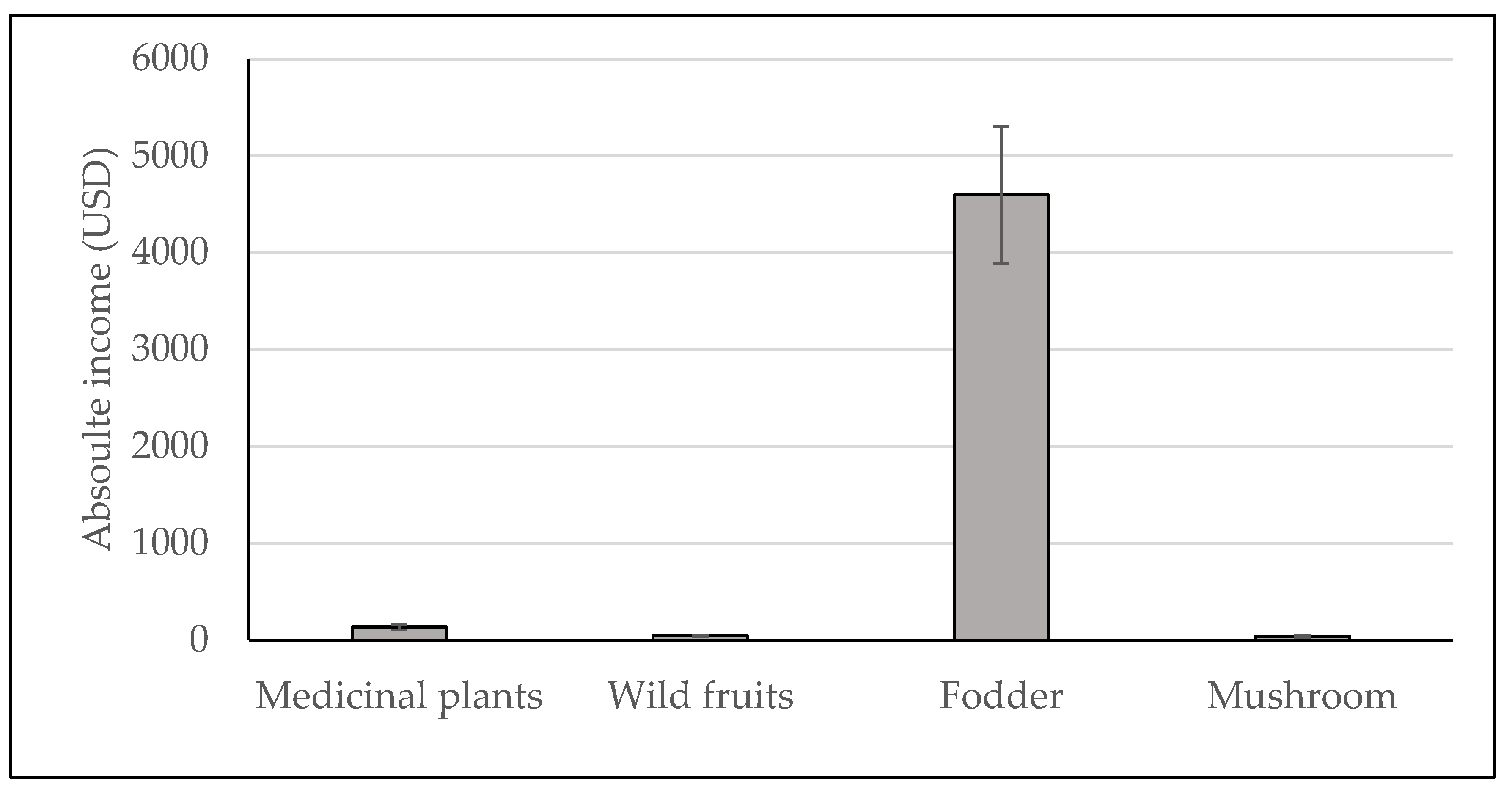
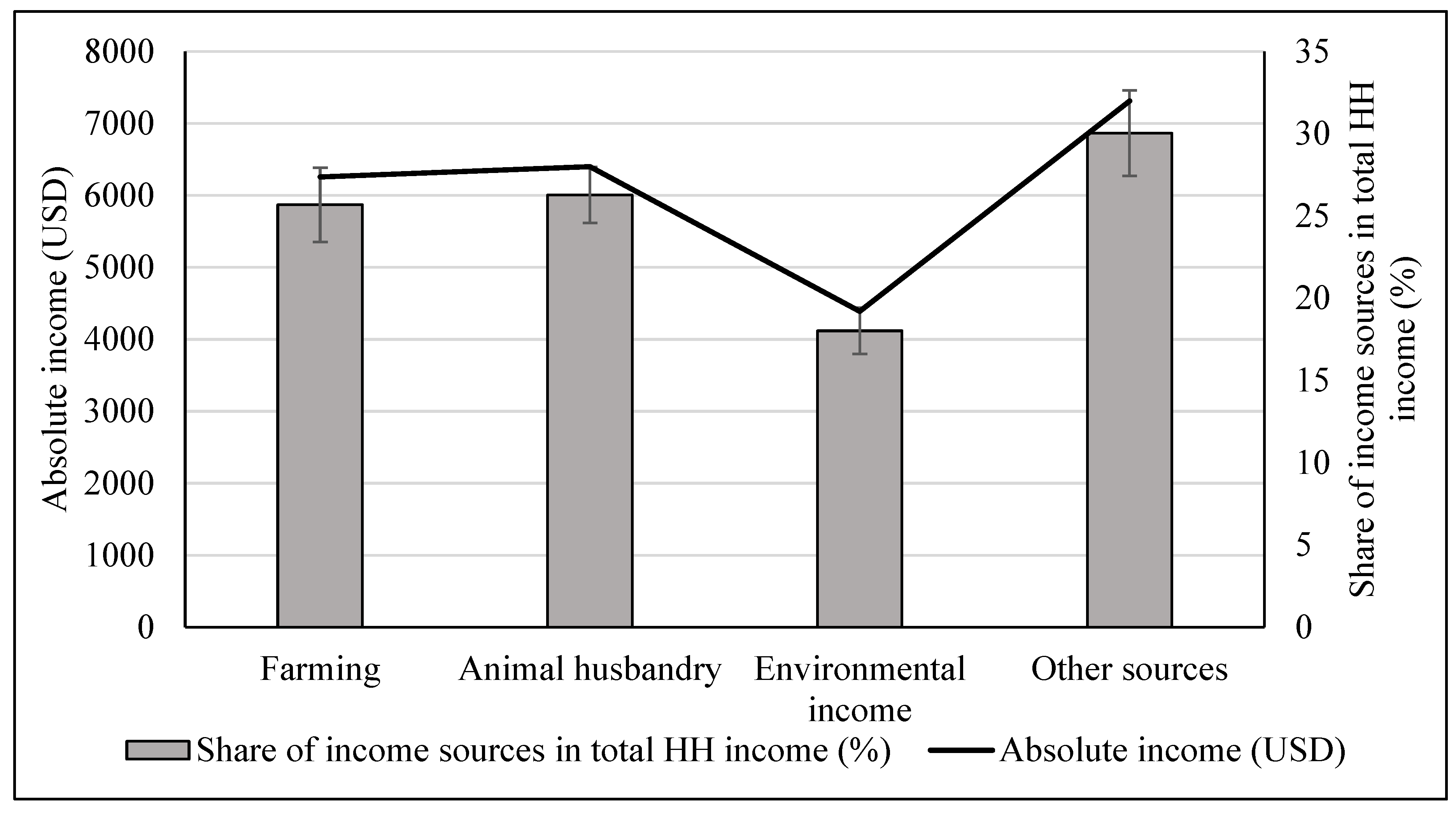
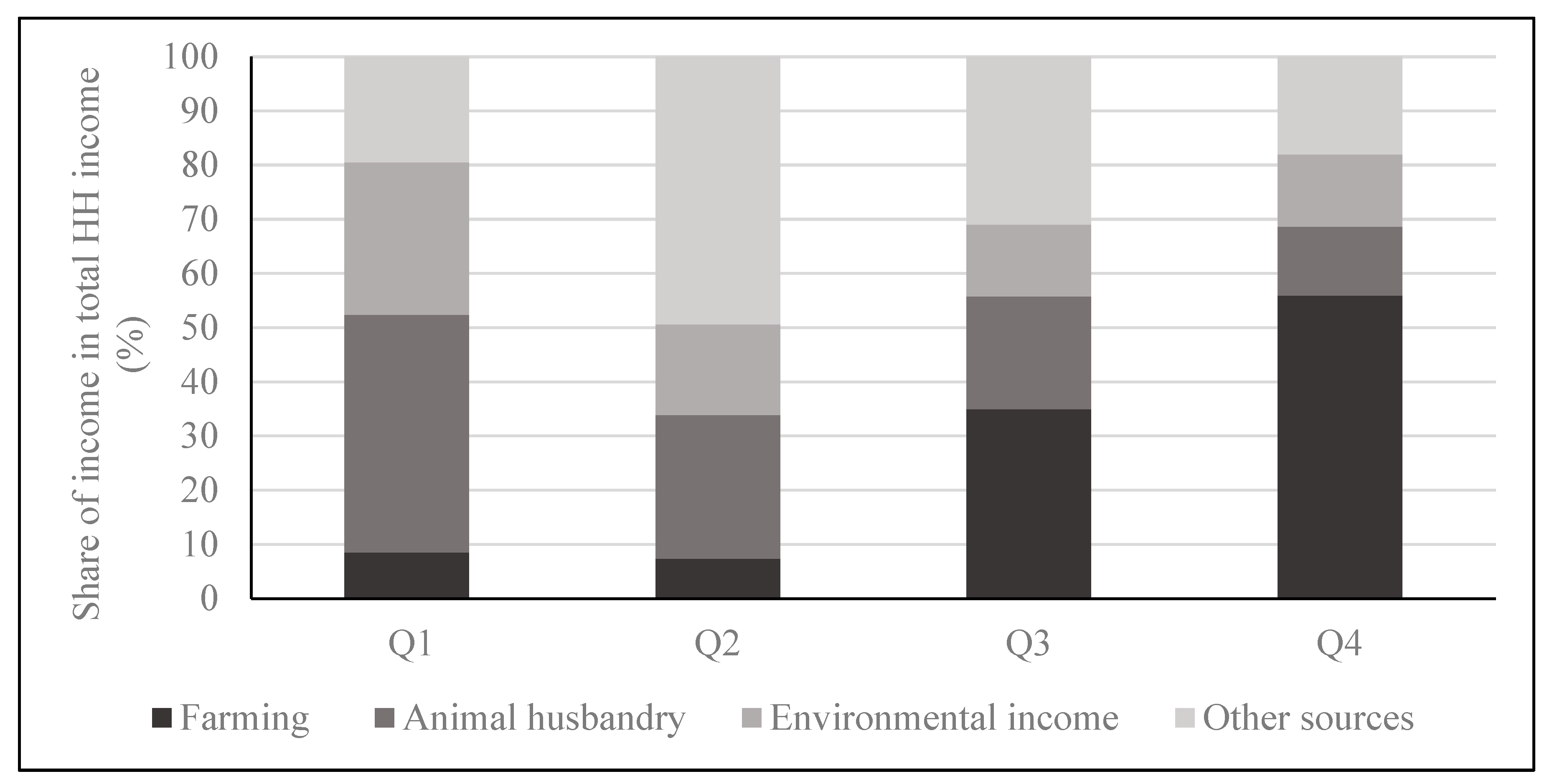
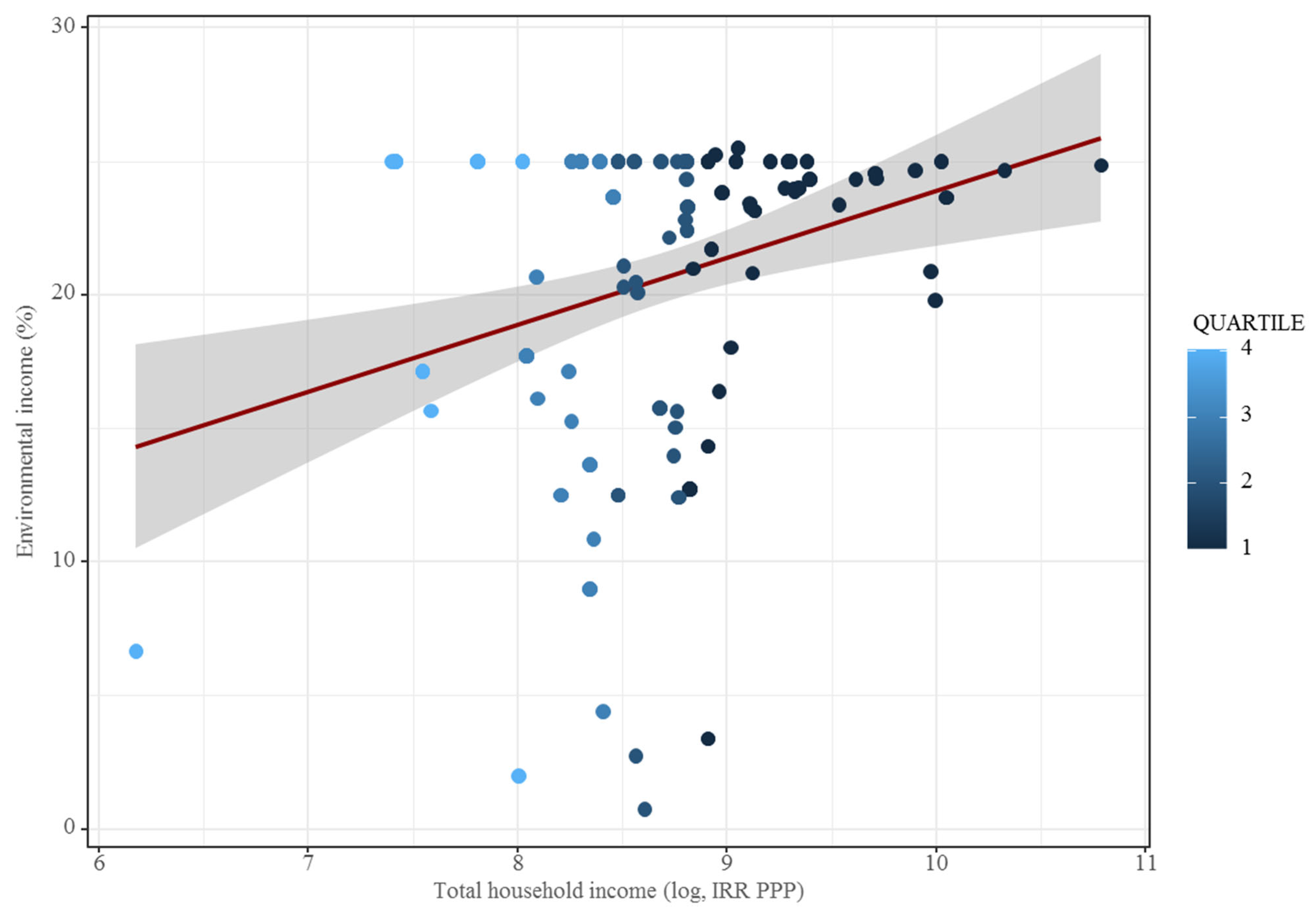
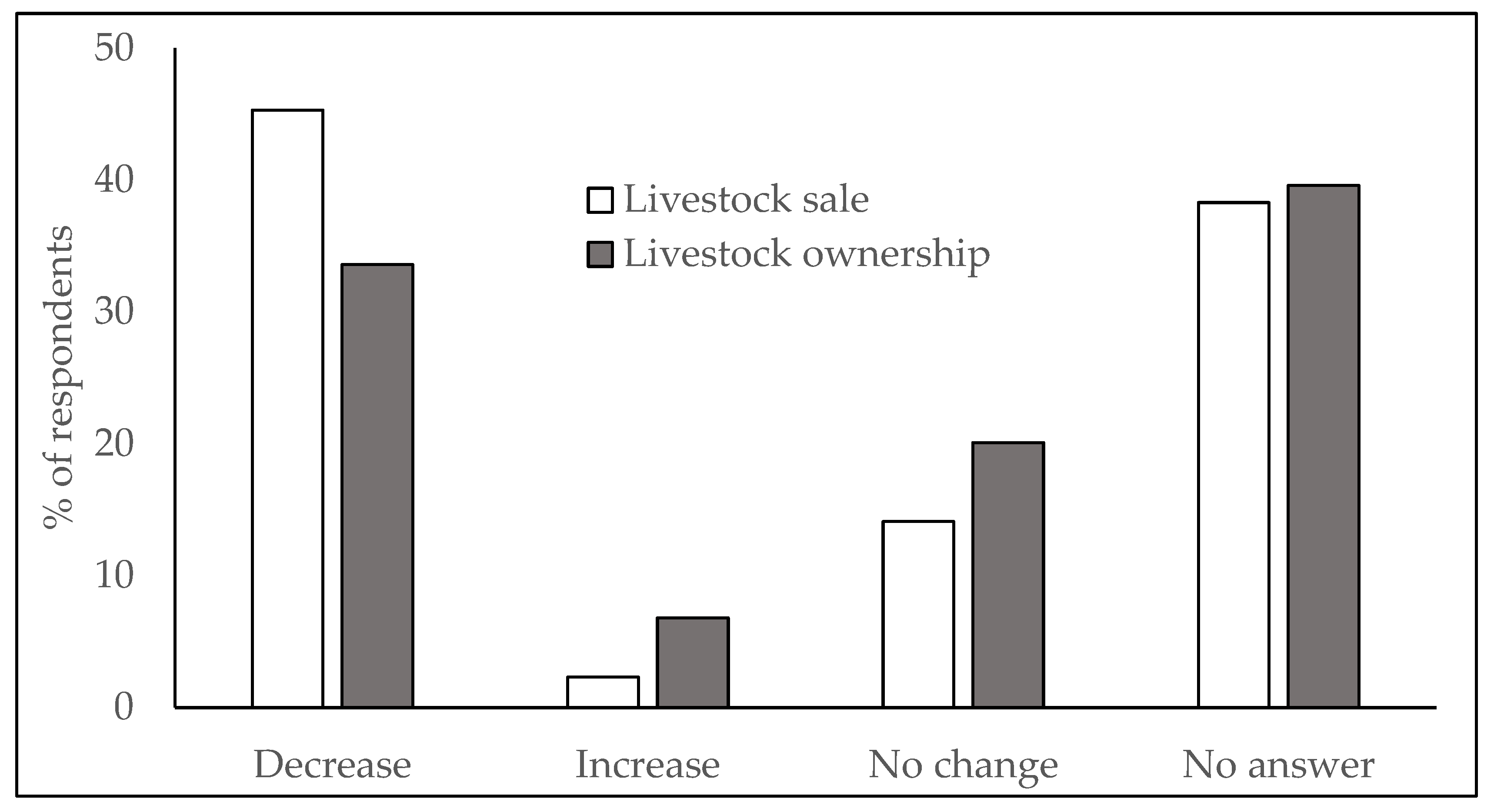


| Variable | Expected Sign | Comments | |
|---|---|---|---|
| Relative Forest Income | Total Income | ||
| Age of respondent (years) | − | + | Young households rely more on forest extraction, and older households have higher total income [12,33,34,35] |
| Age square of respondent (years) | + | − | Younger and older households rely more on forest income and have lower total income, i.e., the effect is not linear with age [12] |
| Female-headed household (0 = female) | + | − | Female-headed (dummy = 1) households have fewer land and livestock assets than male-headed households and hence rely more on lower remunerative forest extraction activities, meaning higher relative forest income and lower total income [35,36] |
| Education (years) | − | + | High-educated households have more access to income opportunities and hence lower forest reliance and higher total income [9,11,35,37] |
| Household size (no. of persons) | + | + | More people means more available labor, some of which is allocated to forest product collection [12,38,39] |
| COVID effect on daily life (0 = no) | + | − | COVID-19 lowers total income and pushes people into higher reliance on forest products [24,40] |
| Agricultural land owned (ha) | − | + | More agricultural land means less reliance on forest products and higher total income [35,41,42]; |
| Number of livestock | − | + | More livestock means less reliance on forest products and higher total income [41] |
| Animal husbandry (0 = no) | − | + | Engagement in animal husbandry means lower forest reliance and higher total income [36] |
| Variable | Relative Forest Income | Total Income |
|---|---|---|
| Age of respondent (years) | 0.128 (0.346) a | −0.854 ** (−2.287) |
| Age of respondent square | −0.153 (−0.412) | 0.845 ** (2.254) |
| Female-headed household (0 = female) | 0.027 (0.361) | −0.054 (−0.712) |
| Education (years) | −0.046 (−0.62) | −0.008 (−0.11) |
| Household size (no. of persons) | 0.001 (0.019) | 0.024 (0.35) |
| COVID effect on daily life (0 = no) | −0.001 (−0.009) | −0.044 (−0.581) |
| Agricultural land owned (ha) | −0.141 ** (−2.084) | 0.146 ** (2.124) |
| Number of livestock | 0.076 (1.006) | −0.049 (−0.635) |
| Animal husbandry (0 = no) | −0.237 *** (−3.09) | −0.121 (−1.563) |
Disclaimer/Publisher’s Note: The statements, opinions and data contained in all publications are solely those of the individual author(s) and contributor(s) and not of MDPI and/or the editor(s). MDPI and/or the editor(s) disclaim responsibility for any injury to people or property resulting from any ideas, methods, instructions or products referred to in the content. |
© 2023 by the authors. Licensee MDPI, Basel, Switzerland. This article is an open access article distributed under the terms and conditions of the Creative Commons Attribution (CC BY) license (https://creativecommons.org/licenses/by/4.0/).
Share and Cite
Ghanbari, S.; Smith-Hall, C.; Jafari, M.; Eastin, I. COVID-19 and Rural Households’ Environmental Incomes in Iran. Forests 2023, 14, 1918. https://doi.org/10.3390/f14091918
Ghanbari S, Smith-Hall C, Jafari M, Eastin I. COVID-19 and Rural Households’ Environmental Incomes in Iran. Forests. 2023; 14(9):1918. https://doi.org/10.3390/f14091918
Chicago/Turabian StyleGhanbari, Sajad, Carsten Smith-Hall, Mostafa Jafari, and Ivan Eastin. 2023. "COVID-19 and Rural Households’ Environmental Incomes in Iran" Forests 14, no. 9: 1918. https://doi.org/10.3390/f14091918
APA StyleGhanbari, S., Smith-Hall, C., Jafari, M., & Eastin, I. (2023). COVID-19 and Rural Households’ Environmental Incomes in Iran. Forests, 14(9), 1918. https://doi.org/10.3390/f14091918








